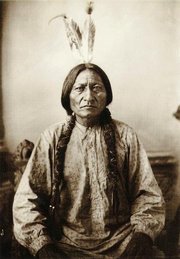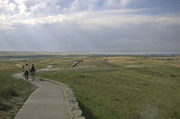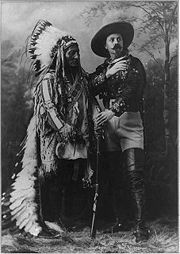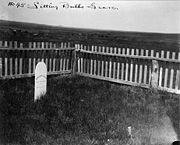Sitting Bull
2008/9 Schools Wikipedia Selection. Related subjects: Historical figures
| Sitting Bull | |
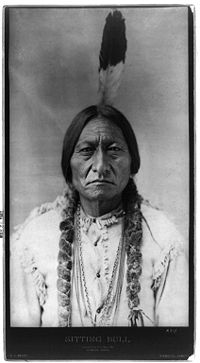 Sitting Bull in 1885
|
|
| Born | Hoka-Psice (Jumping Badger), later Tȟatȟaŋka Iyotȟaŋka (Sitting Bull) c. 1831 Near the Grand River, South Dakota |
|---|---|
| Died | December 15, 1890 Standing Rock Indian Reservation |
| Nationality | Lakota Sioux |
| Other names | Hunkesni (Slow), Hoka-Psice (Jumping Badger) |
| Occupation | Holy man, war chief |
| Height | 5'10" |
| Spouse(s) | Light Hair, wife Red Woman, wife Four Robes, wife Snow-on-Her, wife Seen-by-her-Nation, wife |
| Children | One Bull, adopted son Crow Foot, son Many Horses, daughter Walks Looking, daughter, Annie Oakley, adopted daughter |
| Parents | Tatanka-Iyotanka (Sitting Bull) later (Jumping Bull), father Her-Holy-Door, mother |
| Relatives | Big Foot, half brother White Bull, nephew |
| Signature | |
Sitting Bull ( Lakota: Tȟatȟaŋka Iyotȟaŋka or Ta-Tanka I-Yotank, also nicknamed Slon-he or "Slow"; ca. 1831 – December 15, 1890) was a Hunkpapa Lakota Sioux holy man, born near the Grand River in South Dakota and killed by police on the Standing Rock Indian Reservation during an attempt to arrest him and prevent him from supporting the Ghost Dance movement.
He is notable in American and Native American history for his role in the major victory at the Battle of the Little Bighorn against Lt. Col. George Armstrong Custer and the U.S. 7th Cavalry Regiment on June 25, 1876, where Sitting Bull's premonition of defeating the cavalry became reality. In the months after the battle, Sitting Bull fled the United States to Wood Mountain, Saskatchewan, Canada, where he remained until 1881, at which time he surrendered to American forces. A small remnant of his band under Chief Wambligi decided to stay at Wood Mountain. After his return to the United States, he briefly toured as a performer in Buffalo Bill's Wild West show.
After working as a performer, Sitting Bull returned to the Standing Rock Agency in South Dakota. Because of fears that he would use his influence to support the Ghost Dance movement, Indian Affairs authorities ordered his arrest. During an ensuing struggle between Sitting Bull's followers and the police, Sitting Bull was shot in the side and head by Native-American police after they were fired upon by his supporters. His body was taken to nearby Fort Yates for burial, but in 1953, his remains possibly were exhumed and reburied near Mobridge, South Dakota by Sioux who wanted his body to be nearer to his birthplace. However, some Sioux and historians dispute this claim and believe that any remains that were moved were not those of Sitting Bull.
Early life
Childhood
Sitting Bull was born with the name Hoka-Psice (Jumping Badger), which was understood by members of his tribe as only a temporary name. His father was named Tȟatȟaŋka Iyotȟaŋka (Sitting Bull, after whom he would later be named), his mother was named Her-Holy-Door, and he had a sister, six years older than him, named Good Feather. As a youth, Slow excelled at foot races and was an expert horseback rider and was very accurate with a bow and arrow.
At about the age of 14, Slow participated in a war party that met Crow warriors. He overtook one of the warriors during their retreat, and knocked the Crow off his horse. For this, Slow earned a white eagle feather, symbol of a first coup, and also received the name of his father. His father changed his name to Jumping Bull, and henceforth Slow would be known as Tatanka-Iyotanka, or Sitting Bull. It was also at this ceremony that Sitting Bull received a personalized shield from his father, which was richly decorated with a scene depicting one of his father's dreams and consecrated by the band's medicine man.
Marriage and family
Sitting Bull's early family history is not clear, but his first marriage likely took place in 1851 to a woman named Pretty Door or Light Hair. By 1857, Sitting Bull's marriage to Light Hair produced a son (who died of disease at a young age), but Light Hair died during childbirth. Sitting Bull adopted his nephew, One Bull, at the time of his biological son's death. Also in 1857, Sitting Bull adopted a young Assiniboine as his brother, and he came to be known as Jumping Bull (a tribute to Sitting Bull's father).
Status as holy man
Sitting Bull became a Sioux holy man, or wičaša wakaŋ, during his early twenties. His responsibilities as a holy man included understanding the complex religious rituals and beliefs of the Sioux, and also learning about natural phenomena that were related to the Sioux beliefs. Sitting Bull had an "intense spirituality that pervaded his entire being in his adult years and that fueled a constant quest for an understanding of the universe and of the ways in which he personally could bring its infinite powers to the benefit of his people." Sitting Bull also knew techniques of healing and carried medicinal herbs, though he was not a medicine man.
Because of his status as a wichasha wakan, Sitting Bull was a member of the Buffalo Society, a dream society for those who dreamt of buffalo. He also was a member of the Heyoka, a society for those who dreamed of thunderbirds.
Warrior life
Dakota War of 1862 and its aftermath
As a result of treaty violations by the United States during the late 1850s and early 1860s, eastern bands of the Dakota (one of the three major divisions of the Sioux, along with the Lakota and Nakota) became increasingly agitated with both white settlers and traders alike. On August 17, 1862, a skirmish between Dakota hunters and white settlers resulted in a Dakota war council decision to attack white settlements throughout southern Minnesota. However, by late 1862, the Dakota were forced to surrender and were expelled from Minnesota.
Although the Lakota largely were unaffected by the war, some Dakota refugees (some of whom had refused to surrender to United States forces) from Minnesota moved into Lakota territory along the Missouri River, and Minnesota regiments pursued them. In 1863, Hunkpapa warriors joined with Dakota refugee warriors to fight against the military. However, Col. Henry Sibley defeated them at the Battle of Dead Buffalo Lake on July 26, 1863 and at the Battle of Stony Lake on July 28, 1863. Sitting Bull likely participated in both of these battles, and also possibly took part among other Hunkpapa warriors in the Battle of Whitestone Hill on September 3, 1863. As in the previous battles, the Army prevailed, killing about 100 Sioux and capturing about 160.
The Hunkpapa retreated after this defeat, though the Lakota were aware of the military's intentions to continue the fighting. In June 1864, Gen. Alfred Sully led American forces out from Fort Sully (a few miles south of Fort Pierre, South Dakota). To counter their advance up the Cannonball River, several bands of the Lakota and Dakota Sioux had assembled in camp at the foot of the Killdeer mountains. Among these several thousand warriors were both Sitting Bull and his elder nephew White Bull, who was preparing to fight in his first battle.
At the Battle of Killdeer Mountain, which took place July 28, 1864, the Sioux attacked Sully's assembled forces, but were defeated overwhelmingly by the soldiers' combined artillery and rifles. Sitting Bull's uncle, Four Horns, was wounded though survived, and the Sioux retreated. However, they attacked Sully's forces again from August 7 to August 9, 1864, and were defeated again. Sitting Bull made efforts to persuade the Sioux forces to withdraw, and as a result of his pleas and Sully's second victory, the Sioux pulled back from attacking Sully's column as it continued through the Badlands. The several bands broke up after Killdeer Mountain, and Sitting Bull and a group of Hunkpapas moved southeast.
On September 2, 1864, Sitting Bull and the Hunkpapas attacked a wagon train of emigrants led by Capt. James L. Fisk that was traveling through Sioux lands. Sitting Bull again was wounded, this time through the hip and back. The emigrants forted up and a standoff ensued until the Sioux eventually gave up and retreated to track buffalo. The fighting from 1863 to 1864 caused Sitting Bull to harden his views about the presence of whites in Sioux lands, and he assumed a sense of uncompromising militancy against whites that would characterize him for the rest of his life.
Red Cloud's War
Sitting Bull led numerous war parties against Fort Berthold, Fort Stevenson, and Fort Buford and their environs from 1865 through 1868. Although Red Cloud was a leader of the Oglala Sioux, his leadership and attacks against forts in the Powder River Country were accompanied by Sitting Bull's guerrilla attacks on emigrant parties and smaller forts throughout the upper Missouri River region.
By early 1868, the U.S. government desired a peaceful settlement to Red Cloud's War, and agreed to Red Cloud's demands that Forts Phil Kearny and C.F. Smith be abandoned. Chief Gall of the Hunkpapas (among other representatives of the Hunkpapas, Blackfeet, and Yankton Sioux) signed a form of the Treaty of Fort Laramie on July 2, 1868 at Fort Rice (near Bismarck, North Dakota). However, Sitting Bull did not agree to the treaty and continued his hit-and-run attacks on forts in the upper Missouri area throughout the late 1860s and early 1870s.
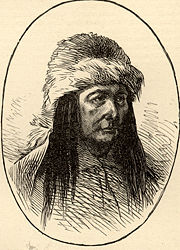
Black Hills War
Sitting Bull's band of the Hunkpapas continued to make attacks on emigrant parties and forts in the late 1860s, but in 1871, the Northern Pacific Railway conducted a survey for a route across the northern plains directly through Hunkpapa lands. The 1871 survey encountered stiff Sioux resistance, and in 1872, the surveyors were accompanied by federal troops. This survey party also was resisted by Sitting Bull and the Hunkpapa, and was forced to turn back. In 1873, the military accompaniment for the surveyors was considerably larger, but Sitting Bull's forces resisted this survey "most vigorously."
However, the Panic of 1873 forced the backers (such as Jay Cooke) of the Northern Pacific Railway's into bankruptcy. This halted the construction of the railroad through Sioux territory, but also encouraged interest in the possibility of gold mining in the Black Hills. A military expedition led by Lt. Col. George Armstrong Custer in 1874 left from Fort Abraham Lincoln, near Bismarck, to explore the Black Hills for gold and to determine a suitable location for a military fort in the Hills. Custer's announcement of gold in the Black Hills triggered the Black Hills Gold Rush and increased tensions between the Sioux and whites seeking to move into the Black Hills.
Although Sitting Bull did not attack Custer's expedition in 1874, the government was increasingly pressured to open the Black Hills to mining and settlement based on reports of Sioux depredations (encouraged by Sitting Bull). In November 1875, the government accordingly ordered all Sioux bands outside the Great Sioux Reservation to move onto the reservation, with the knowledge that these bands would not comply. These bands living off the reservation were certified by the Interior Department as hostile on February 1, 1876. This certification allowed the military to pursue the Sioux and Sitting Bull.
Battle of Little Bighorn
Lt. Col. George Armstrong Custer, a decorated Union veteran of the Civil War, was an ambitious military officer with presidential hopes in the early 1870s. His Civil War exploits and his presence at Lee's surrender at Appomattox had made Custer a household name by the time he began his career fighting the Sioux. He was well-known among Native Americans and his fame among whites grew ever-larger as the result of a series of controversial battles and early dawn attacks against Native American camps.
Sitting Bull's influence was growing larger as a result of his militant stance against white intrusions on Sioux lands. By the mid-1870s, Sitting Bull had garnered great respect even among other bands of the Sioux, while his guidance also impacted the Northern Cheyenne and the Northern Arrapahoes.
On June 25, 1876, Custer’s 7th Cavalry advance party of General Alfred Howe Terry’s column attacked Indian tribes at their camp on the Little Big Horn River expecting a similar victory. The U.S. army did not realize that before the battle began, more than 3,000 Native Americans had left their reservations to follow Sitting Bull. The attacking Sioux, inspired by a vision of Sitting Bull’s, in which he saw U.S. soldiers being killed as they entered the tribe’s camp, fought back. Custer's badly outnumbered troops lost ground quickly and were forced to retreat, as they began to realize the true numbers of the Native American force. The tribes then led a counter-attack against the soldiers on a nearby ridge, ultimately annihilating the soldiers.
The Native Americans' celebrations were short-lived, however, as public outrage at Custer's death and defeat and the heightened awareness of the remaining Sioux brought thousands more soldiers to the area. Over the next year, the new American military forces pursued the Lakota, forcing many of the Indians to surrender. Sitting Bull refused to surrender and in May 1877 led his band across the border into Saskatchewan, Canada where he remained in exile for many years near Wood Mountain, refusing a pardon and the chance to return.
Surrender
Hunger and cold eventually forced Sitting Bull, his family, and nearly 200 other Sioux in his band to return to the United States and surrender on July 19, 1881. Sitting Bull had his young son Crow Foot surrender his rifle to the commanding officer of Fort Buford, and he told the soldiers he wished to regard them and the white race as friends. Two weeks later, Sitting Bull and his band were transferred to Fort Yates, the military post located adjacent to the Standing Rock Agency.
Arriving with 185 people, his band was kept separate from the other Hunkpapa gathered at the agency. Army officials remained concerned that the famed Hunkpapa chief would use his influence to stir up trouble among the recently surrendered northern bands. Consequently, the military decided to transfer him and his band to Fort Randall to be held as prisoners of war. Again loaded on a steamboat, Sitting Bull's band, now totaling 172 people, were sent downriver to Fort Randall where they spent the next 20 months. He was finally allowed to return to the Standing Rock Agency with his band in May 1883.
Wild West Show participation
In 1885, Sitting Bull was allowed to leave the reservation to join Buffalo Bill Cody’s Wild West show. He earned about $50 a week for riding once around the arena, where he was a popular attraction. Although it is rumored that he often cursed his audiences in his native tongue during the show, some historians argue that he did not, and there have been reports that Sitting Bull in fact gave speeches relaying his desire for education for the young and the normalization of relations between the Sioux and whites. Sitting Bull also was reported to have cursed his audience during an opening address celebrating the completion of the Northern Pacific Railway in 1884.
Sitting Bull only stayed with the show for four months before returning home. However, during that time, he had become somewhat of a celebrity and a romanticized freedom fighter. He earned a small fortune by charging for his autograph and picture, although he often gave away his money to the homeless and beggars. During this time, Sitting Bull realized that his enemies were not limited to the small military and settler communities he had encountered in his homelands, but in fact they were numerous and possessed technological advancements. He also realized that the Sioux would be overwhelmed if they continued to fight.
Death and burial
Sitting Bull returned to the Standing Rock Agency in South Dakota. Because of fears that he would support the Ghost Dance movement, Indian Affairs authorities ordered him arrested. During a struggle between Sitting Bull's followers and the police on December 15, 1890, Sitting Bull was shot in the side and head by police after they were fired upon by his supporters. His body was taken to Fort Yates for burial, but in 1953, his remains were exhumed and reburied near Mobridge, South Dakota by Sioux who wanted his body to be nearer to his birthplace. However, some Sioux and historians dispute this claim and believe that any remains that were moved were not those of Sitting Bull.
Legacy
Following his death, his cabin on the Grand River was taken to Chicago to become part of the 1893 Columbian Exhibition. The cabin was exhibited along with Native American dances and a sign that said "War Dance Given Daily." Later, Sitting Bull became the subject of or a character in several Hollywood motion pictures, such as Sitting Bull: The Hostile Sioux Indian Chief (1914), Sitting Bull at the Spirit Lake Massacre (1927), Sitting Bull (1954), Buffalo Bill and the Indians or Sitting Bull's History Lesson (1976), and Bury My Heart at Wounded Knee (2007).
As time passed, Sitting Bull's legacy became a product of the public's lasting perception of him as an archetype of Native American resistance movements. Legoland Billund, the first Legoland park, contains a Lego sculpture of Sitting Bull, which is the largest sculpture in the park. On September 14, 1989, the United States Postal Service released a postage stamp featuring a likeness of Sitting Bull with a denomination of 28¢. On March 6, 1996, the Standing Rock Sioux tribal council voted to rename Standing Rock College (formerly Standing Rock Community College) as Sitting Bull College in honour of Sitting Bull.

